Be My Violet
February 14, 2021
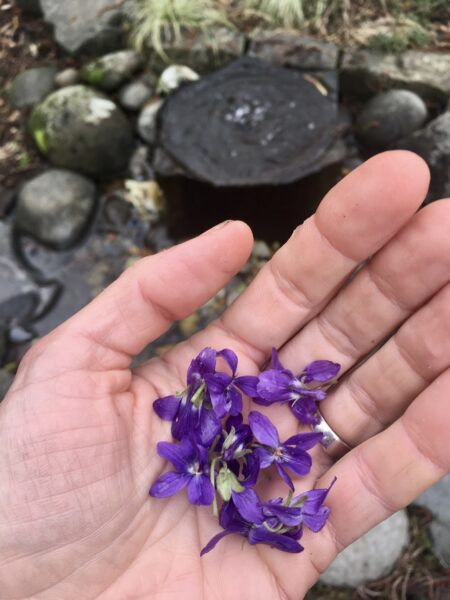
Many years ago, with a basket hooked in one elbow and my young son’s small hand in the other, I walked through the welcome sun of a February day.
Neighborhood drifts of green-hearted leaves, dotted with purple flower faces, our destination. The small patch of sweet violets in our home garden were too few for my florid cake decorating intentions.
We gathered only the whole, the best, the most intact blossoms. None torn or slug-bitten, none peed on by four-leggeds, none past their prime with pollen faded, sweetness gone.
Into the basket the regal fairy wings went, then home to dip in egg whites, dredge in sugar and dry. But, oh, to keep the flower faces showing, petals flat and wide, radiating out from the central dot of golden anther—impossible.
Alder’s fifth birthday cake was decorated not with perfection, but with sugared blobs of purple love. All that effort was a one-time experiment, but my love of violets never waned.
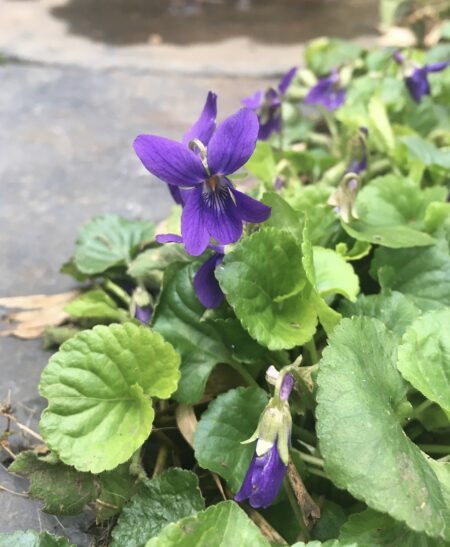
sweet violet
Sweet violets (Viola odorata)
As a crevice filler, a ground cover, an early blooming mood brightener in the frosted fog days of February, violets are a gift. Sweet violets (Viola odorata) are typically purple, but, as I learned in my young days as a gardener out River Road, they also bloom in pink, maroon, white, and shades in between. And, luckily, they don’t even need to be candied to be enjoyed. Pop some in your mouth in passing, sprinkle your salad with their purpled confetti, make a fresh cup of tea. Lovely.
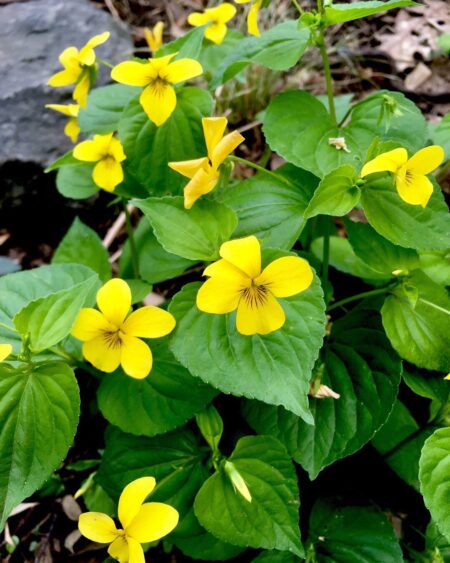
stream violet
PNW native violets
Have you met our western native violets? Early blue violet (Viola adunca) is similar to the sweet one, but a bluer flavor of purple. It lushly grows in sun or dapple shade in meadows or near streams. Many endangered butterflies feed on it as larva. Celebrate signs of munching as only a habitat-minded gardener can. Plant it in your garden at the edge of a path, under roses and taller summer perennials, in crevices between rocks and paving, or with its fellow natives: woodland strawberry (Fragraria vesca) and Roemer’s fescue (Festuca roemeri).
From the other side of the color wheel, you can grow western native stream violet (Viola glabella). With yellow blossoms and an easy nature, they’re welcome in every garden. And for four season green, try evergreen violet (Viola sempervirens), also flowering yellow. The first is happiest in a moist forest scene, while the latter can take the dryness under large trees. It hails from redwood country where it spreads amongst the endless roots and deep-needled duff of those giants. Both of these natives prefer shade.
A quick look at the Oregon Flora website (such a great resource!) shows over forty species of viola native to our state. These three described above are the only I’ve found so far in the nurseries, but you know I’ll be keeping my eye out for others!
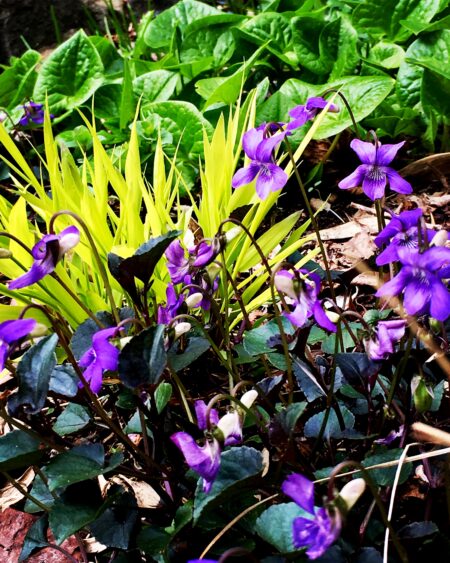
labrador violet
Labrador violet (Viola labradorica)
When you really want to cover bare ground in a royal way, this is the violet for you. From the northeastern U.S., Canada, and Greenland, labrador violet (Viola labradorica) dresses up with purple leaves, heart-shaped like the others in this genus, and with bright purple blooms dancing atop those dark leaves. The thing to know about this one is that it will spread a lot. In most gardens this is seen as a benefit—covered ground grows no weeds, but if you recognize yourself as uncomfortable with plants of vigorous nature, know this one has a will of its own. Years ago, it ran around stepping stones in one of our gardens mingling with the equally spirited golden creeping jenny (Lysimachia nummularia ‘Aurea’). That made for a very colorful little pathway along the side of the house. Ferns and hellebores emerged above this mottled ground and a grape arbor overhead tempted with ripening clusters of color coordinating fruits.
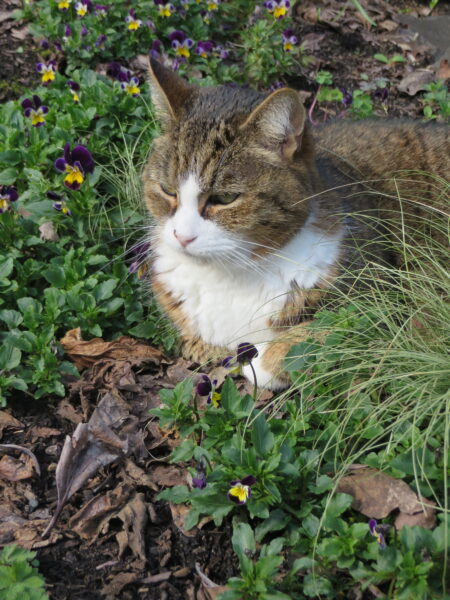
Montana kitty in the Johnny-Jump-Ups
Johhny-Jump-Ups (Viola tricolor)
Kids know this one, or at least they used to when they were free to romp around the garden rather than being shut up indoor on devices. The purple and yellow faces cavorting around the earliest spring bulbs jump up to greet spring and frolic like children themselves. My husband Aaron never cared for their color combination, maybe it’s clownish, but its cultivar ‘Bowles Black’ looks good to everyone. It’s the little black dress of violas. Whatever your preference, do try growing Viola tricolor from seeds sewn in fall or earliest spring. Seeds are cheap and these don’t require much of an overly conscientious green thumb to thrive. In fact, they’re a reliably self-seeding annual, so once you get a community going, they’ll keep popping up here and there on their own year to year. I love this dynamic nature. It keeps you coming back to see what’s happening now, and again, and again.
Horned violet (Viola cornuta cvs.)
Whiskered faces in every color from blackberry to blush, pumpkin to clear yellow are easy to find in nurseries from this hybrid perennial. Usually mixed in with the big, floppy, annual pansies, look closely at the tags for anything mentioning perennial or the species name V. cornuta. I always change the plantings in my pots on the deck and patio in early fall and, without fail, some horned violets find their way into the mix. Pumping out waves of bloom fall through winter, then exploding in spring, I absolutely love them. Their colors bring joy on gray days and their spilling habit looks gorgeous with potted daffodils, and tulips. Since they’re inexpensive, you can treat them as annuals when it’s time to bring alyssum, lobelia, and callibrachoa into the pots for summer, or you can trim them back and move them in between perennials or stepping stones.
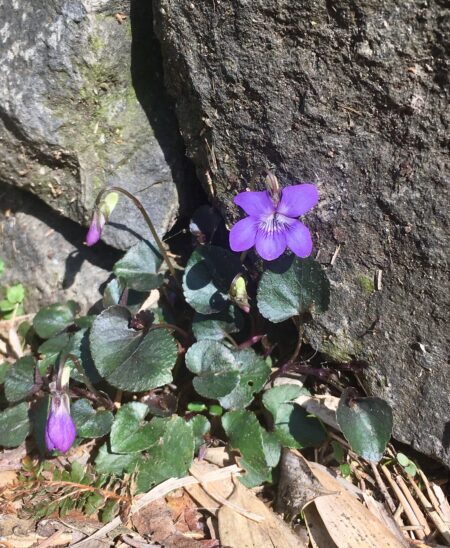
a violet for every nook and cranny
Your garden always has room for more diversity of ground covers. If weeds grow, plant violets, cover the ground. Choose something easy, something beautiful and edible and heart-warming for the dragging days of late winter. Choose to plant violets.

I love your descriptions! They brought me right back to those places. And Montana kitty, oh, so plush!
We have some Labrador violets and some yellow natives, along with our sweet baby, Violet. I tried to come up with a color scheme for her nursery and couldn’t do it. Then I remembered the gardens you mentioned and the many shades of violets and it fit perfectly!
Rachel, your baby girl Violet is surely the sweetest of all from this type. I hope to meet her soon. Much love to you and your family!